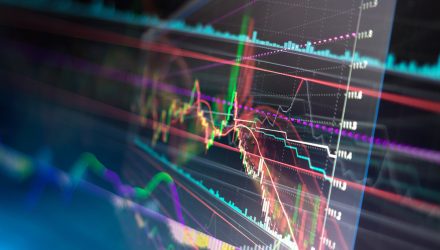The Alerian Energy Infrastructure ETF (ENFR) is up 40% year-to-date, and it yields an eye-catching 5.46%.
Alone, either of those statistics is impressive. Put them together under the umbrella of a single exchange traded fund, and they’re even more impressive. Focusing on ENFR’s dividend yield, it certainly fits the bill as “high,” and, broadly speaking, there are some risks associated with high dividend stocks. However, ENFR’s underlying index, the Alerian Midstream Energy Select Index (CME: AMEI), might just have more quality than investors initially think.
“Within the Alerian energy infrastructure index suite, companies with investment-grade credit ratings represent approximately 57% of MLP indexes by weighting and upwards of 80% for broad midstream indexes,” says Alerian analyst Stacey Morris.
Nearly 70% of the members of ENFR’s index carry investment-grade credit ratings, a percentage that tops those found on some other benchmarks that are heavy on master limited partnerships (MLPs) — a traditionally high-yielding asset class.
That’s relevant because credit usually leads equity, and one way of looking at that statement is that companies with junk credit ratings and heavy dividend obligations are often among the most vulnerable to payout cuts and suspensions. In rocky markets, bondholders and other investors may force those companies to reduce payouts to conserve cash.
Additionally, the Alerian Midstream Energy Select Index’s current percentage of investment-grade ratings, while decent, implies that there’s room for members of that benchmark to attain that coveted status. If that happens, ENFR holdings could move to the upside because higher credit ratings reduce financing costs for corporate debt issuers.
One more thing to consider: The current dividend yield on the Alerian Midstream Energy Select Index is about 100 basis points below the five-year average, indicating that it’s not excessively relative to its own historical standards. Plus, ENFR could prove to be a less risky bet from a credit perspective than traditional junk bond funds with a higher yield, too.
“Finally, for additional context, the Bloomberg US Corporate High Yield Index (LF98TRUU) was yielding 4.04% at the end of September. By definition, securities included in the index cannot be investment grade[1]. Admittedly, comparing bond and equity yields is a bit like comparing apples and oranges given different risk profiles and interest payments on bonds taking priority over dividend payments to equity holders. However, it is possible to attain more generous equity yields from companies with a higher credit quality relative to accepting a lower yield on bonds from companies with lower credit quality,” concludes Alerian’s Morris.
Other funds with exposure to income-generating energy assets include the VanEck Vectors Energy Income ETF (EINC) and the Global X MLP ETF (NYSEArca: MLPA).
For more news, information, and strategy, visit our Energy Infrastructure Channel.
The opinions and forecasts expressed herein are solely those of Tom Lydon, and may not actually come to pass. Information on this site should not be used or construed as an offer to sell, a solicitation of an offer to buy, or a recommendation for any product.

